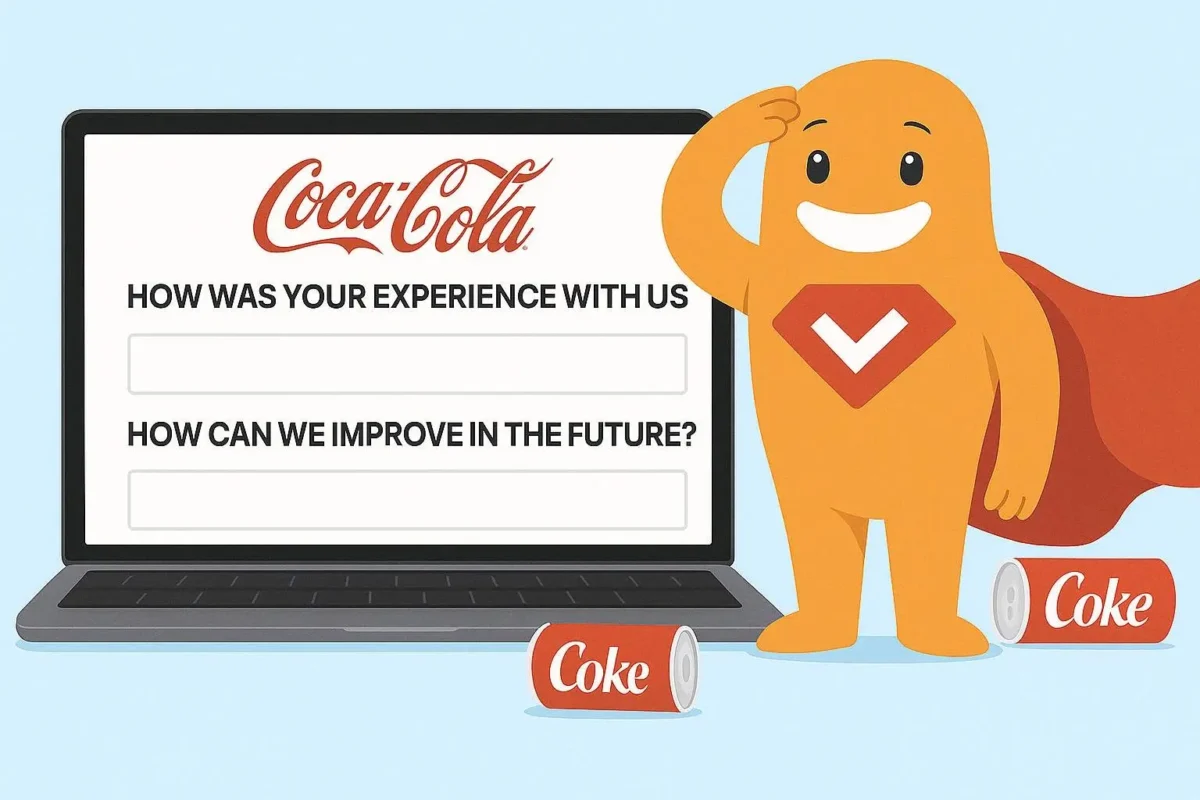There’s something powerful about hearing straight from someone in their own words. While closed-ended questions are great for quick stats, open-ended questions are where the real magic happens. They give survey respondents the space to share raw thoughts, quirky experiences, surprising ideas, or even frustrations you didn’t see coming.
These types of questions reveal insights you may not have considered. They capture more context and help you tap into deeper understanding. If you’ve ever read a customer comment that changed how you thought about your product, you’ve already seen the power of open-ended survey responses.
But as useful as open-ended questions are, getting people to answer them is the tricky part. It turns out that most folks prefer simple answers, like ticking a box or sliding a scale. So, what can you do to encourage respondents to give more meaningful answers? Stick around—we’ve got ten ways to make it happen.
Create Your FREE Survey or Questionnaire Now
Using Open-Ended Survey Questions
You’ve likely come across this type of question before. Something like, “How was your experience with us today?” It seems simple enough, but in the world of survey questions, this open-ended format is doing some serious heavy lifting. You can see more examples of open-ended survey questions in our previous blog on the topic.
Open-ended survey questions are designed to collect qualitative data. Unlike closed-ended questions—those multiple choice or rating scale questions that offer predefined answers—open-ended questions allow respondents to share their thoughts from their perspective, giving you access to a richer and more nuanced understanding.
They also reduce assumptions in survey design and open the door to surprising insights. However, if overused, they may tire out your audience—something known as survey fatigue.
Let’s look at a few examples to show how this works in action:
- After a rating scale question, follow up with: “What could we have done better?”
- Use survey logic to personalize it. If someone gives you a score of 7 or below, display: “What didn’t meet your expectations?”
- If they score you an 8 or higher: “What did we do right that stood out?”
This dynamic approach not only captures detailed responses but also helps you better understand customer preferences, uncover insights, and identify areas for improvement.
Plus, open-ended survey responses can later help you refine your closed-ended questions. If you’re not sure what answer options to include in a multiple-choice question, analyzing those open answers can guide the way. This is called quantitizing qualitative data. Read more about qualitative vs. quantitative surveys.
Of course, there are times when open-ended questions might not be the best fit. Skip them when:
- You need quick, quantitative data only
- You’re running short polls with a limited time
- Your audience lacks motivation or is in a rush
- You’ve already included too many (that can lead to survey fatigue)
Knowing when—and how—to use open-ended feedback is a key part of designing engaging surveys that work.
Create Your FREE Survey or Questionnaire Now
Are Open-Ended Survey Questions Qualitative or Quantitative?
In a word: qualitative.
Open-ended questions are rooted in qualitative research methods because they focus on the feelings, experiences, and opinions of your survey participants. For example, “Were you happy with the service you received?” invites reflection and a personal story. That’s a far cry from a quick number rating.
But here’s where it gets even more useful: you can turn open-ended feedback into quantitative data. This process is called quantizing. By coding responses and identifying key themes, you can say things like “30% of respondents mentioned wait time” or “42% of answers included the word ‘friendly.’” These patterns reveal valuable insights while preserving the depth of the original answer. Learn more about the difference between these methods in our guide to qualitative vs. quantitative surveys.
To get even more from your open-ended data, you can use thematic analysis or sentiment analysis. These qualitative analysis tools help uncover insights by analyzing how different themes appear throughout your responses. Want to take it further? Try open-ended data visualization tools like word clouds, charts, or coding systems to spot trends, analyze responses, and deliver effective data visualization that tells a compelling story.
In short, with the right approach, you can go from messy open-ended data to clean, visualized results packed with meaningful insights.
Challenges of Open-Ended Questions
Getting people to answer open-ended survey questions can be tricky since they require more effort than multiple-choice or rating scales. It’s important to know that open-ended questions have higher non-response rates compared to closed-ended ones. The Pew Research Center found that open-ended questions had an average non-response rate of 18%, with some questions reaching over 50%. They also report that questions requiring more thought or longer responses increase the likelihood of nonresponse. Pew’s analysis indicated that questions demanding multiple sentences had a median nonresponse rate of 18%, compared to 13% for one-word answers.
To help you improve your chances of getting responses on open-ended questions, we have ten tips.
10 Ways To Increase Response Rates on Open-Ended Questions
We know open-ended survey responses are powerful—but how do you get more of them? It takes a little finesse and a lot of empathy. Here are ten proven tips to help your target audience open up and share detailed feedback.
1. Keep It Short and Sweet
Don’t overload your survey with open-ended questions. One or two thoughtfully placed prompts are better than ten ignored ones. People are more likely to respond when they’re not overwhelmed.
2. Be Specific With Your Question
Vague questions lead to vague answers. Instead of “Any thoughts?”, try “What did you enjoy most about the event?” or “What’s one thing we could improve?” Focused prompts make it easier for people to answer without overthinking.
3. Use Thought Starters
Kickstart their memory. Phrases like “Think about your last interaction with us…” or “When you first logged in, what stood out?” can guide their thoughts and lead to more meaningful answers.
4. Make It Feel Personal
Ditch the robotic tone. Warm, conversational language like “We’d really love to hear your thoughts!” feels more human—and makes people more likely to respond honestly.
5. Explain the Why
People want to know that their words matter. Let them know their open-ended feedback will shape product features, improve services, or influence future decisions. When people see that their voice has value, they’re more likely to participate.
6. Offer Incentives
If you really want to get open-ended responses, you might consider offering an incentive. A small reward such as a gift card, promotional offer, or a discount code can go a long way with respondents. There are some potential downsides to incentives—for example, you could attract reward seekers who don’t care about answering questions honestly. So, weigh the pros and cons. We list them out in one of our blogs along with survey incentive ideas.
7. Optimize for Mobile
Most people take online surveys on their phones. If your text box is too small or glitchy, they’ll skip it. Make sure your survey is mobile-friendly, especially when using long text input fields for open-ended responses.
8. Save Open-Ended Questions for the End
By the time someone reaches the end of the survey, they’re more invested. Placing your open-ended questions toward the end increases the likelihood they’ll respond. Pew Research even found higher completion rates for surveys that started with easier questions.
9. Keep Text Boxes Small
Huge input boxes can feel intimidating. A smaller box suggests that just a few sentences are expected, which is much more inviting than a giant blank space. The box can always expand as they type.
10. Follow Up Thoughtfully
If your survey collects contact details, a quick follow-up email or thank-you message goes a long way. Acknowledging their input builds trust and encourages participation in future employee surveys or customer feedback efforts.
Making Sense of the Data
Now comes the fun part: analyzing those open-ended responses.
Start with a qualitative research method like coding. This means reading each response and assigning it a category, or “code.” For example, responses that mention “wait time” might get grouped under “speed.” Over time, you’ll see key themes emerge. These are your building blocks for qualitative analysis.
Want to level up? Use tools like sentiment analysis to get a read on emotional tone. Whether people feel excited, frustrated, or indifferent, sentiment analysis can help highlight trends that numbers alone might miss.
And for visual learners, open-ended data visualization is your friend. Word clouds show which terms pop up the most. Graphs can display the frequency of key themes. These visuals help you present your results in a way that’s easy to digest—especially when you’re sharing with teams or clients.
The whole analysis process might sound complicated, but it pays off. By turning open-ended survey responses into themes, categories, and visuals, you extract meaningful insights that you simply can’t get from a multiple-choice question.
Open-Ended Questions and Your Business Strategy
So why should all this matter to you?
Open-ended questions aren’t just a nice touch—they’re a valuable tool for uncovering what your customers are really thinking. Whether you’re doing market research, running focus groups, or collecting employee surveys, open-ended responses offer the kind of actionable insights that can shape strategy, refine messaging, and build better products.
You’ll learn how people describe your brand in their own words. You’ll spot new feature requests you didn’t plan for. You’ll hear about pain points that data alone would never reveal. And most importantly, you’ll deepen your connection with your audience by actually listening.
Even a single open-ended question at the end of a survey can deliver unexpected insights that change the way you see your business. That’s the power of qualitative data—deeper understanding through personal stories, not just numbers.
Start Today With SurveyLegend
Ready to get some honest, open-ended answers to your survey questions? We’ve got you covered (Be sure to check out our blog on 12 types of survey questions we offer). SurveyLegend’s surveys are fun to create and fun to take, so we have a great track record when it comes to response rates on open-ended survey questions. Plus, we offer a wide variety of close-ended survey questions that can be used in conjunction with the open-ended ones. There are star ratings, emojis, NPS, sliders, and more. Our surveys are optimized for mobile, making the experience great for respondents, and you can choose to use single line text answers or larger text boxes. Get started today for free!
Create Your FREE Survey or Questionnaire Now
Frequently Asked Questions (FAQs)
What kind of answers can you get from open-ended questions?
Responses may vary in length and clarity. Some will be thoughtful and detailed, while others may be brief or vague.
What if people skip open-ended survey questions?
It’s common for people to skip open-ended questions. You can make them optional or add a note explaining why their feedback is valuable. To increase engagement, make questions concise, warm, and specific.
Can open-ended responses on surveys be quantified?
Yes! This is called quantitizing qualitative data. It is accomplished through content analysis and categorization into themes or keywords, which can then be counted and analyzed.



